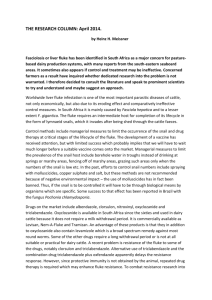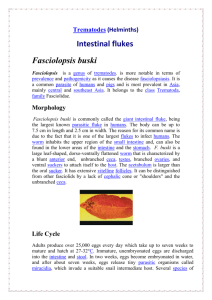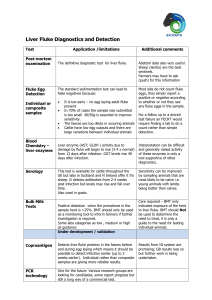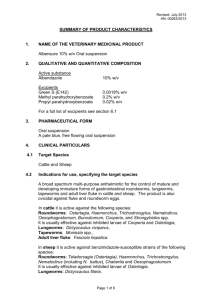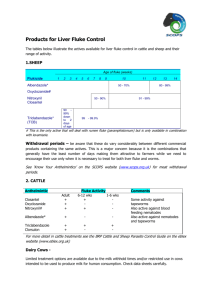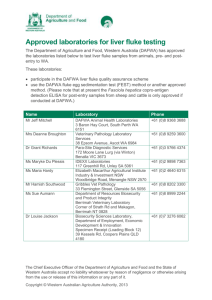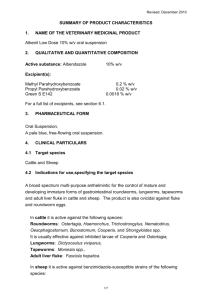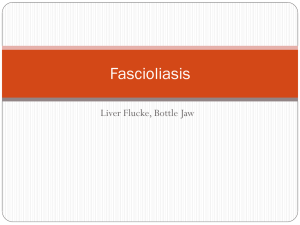Liver Fluke Assessment in US Cattle
advertisement
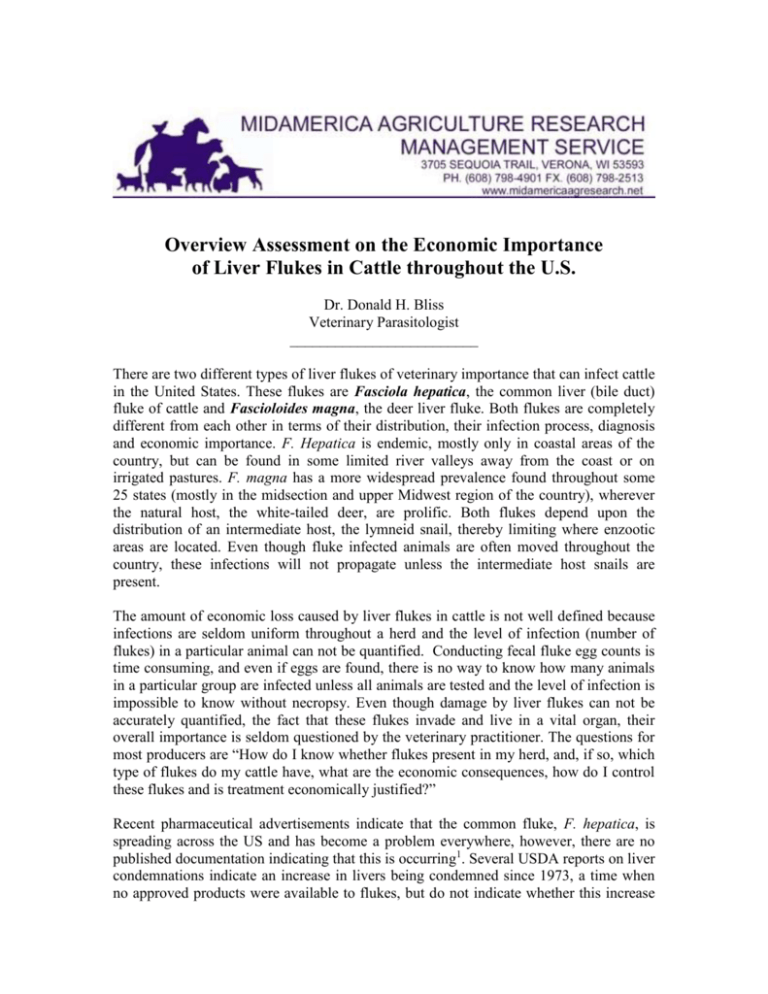
Overview Assessment on the Economic Importance of Liver Flukes in Cattle throughout the U.S. Dr. Donald H. Bliss Veterinary Parasitologist _________________________ There are two different types of liver flukes of veterinary importance that can infect cattle in the United States. These flukes are Fasciola hepatica, the common liver (bile duct) fluke of cattle and Fascioloides magna, the deer liver fluke. Both flukes are completely different from each other in terms of their distribution, their infection process, diagnosis and economic importance. F. Hepatica is endemic, mostly only in coastal areas of the country, but can be found in some limited river valleys away from the coast or on irrigated pastures. F. magna has a more widespread prevalence found throughout some 25 states (mostly in the midsection and upper Midwest region of the country), wherever the natural host, the white-tailed deer, are prolific. Both flukes depend upon the distribution of an intermediate host, the lymneid snail, thereby limiting where enzootic areas are located. Even though fluke infected animals are often moved throughout the country, these infections will not propagate unless the intermediate host snails are present. The amount of economic loss caused by liver flukes in cattle is not well defined because infections are seldom uniform throughout a herd and the level of infection (number of flukes) in a particular animal can not be quantified. Conducting fecal fluke egg counts is time consuming, and even if eggs are found, there is no way to know how many animals in a particular group are infected unless all animals are tested and the level of infection is impossible to know without necropsy. Even though damage by liver flukes can not be accurately quantified, the fact that these flukes invade and live in a vital organ, their overall importance is seldom questioned by the veterinary practitioner. The questions for most producers are “How do I know whether flukes present in my herd, and, if so, which type of flukes do my cattle have, what are the economic consequences, how do I control these flukes and is treatment economically justified?” Recent pharmaceutical advertisements indicate that the common fluke, F. hepatica, is spreading across the US and has become a problem everywhere, however, there are no published documentation indicating that this is occurring1. Several USDA reports on liver condemnations indicate an increase in livers being condemned since 1973, a time when no approved products were available to flukes, but do not indicate whether this increase is normal due to weather fluctuations, better inspections techniques or due to ineffective treatment. Technical experts (from a corporate sponsor) on a recent TV show told a producer from Minnesota and one from Virginia that treating cattle for flukes in their area was very important, however, they forgot to tell the callers that the liver flukes found in Minnesota and Virginia are almost exclusively deer flukes (F. magna) and that their product was not approved for use to control this parasite1. I. Fasciola hepatica, the common liver fluke of cattle is found mainly in Florida, Louisiana, the gulf coast of Texas, parts of California, Hawaii, the coastal Pacific Northwest and some river valleys and irrigated pasture in the Northwest as far east as Montana (see map). Although this fluke can infect some wildlife species such as deer and small ruminants such as sheep and goats, cattle are the main host and continued environmental contamination by cattle is required to perpetuate the infection. A. Life cycle: Adult F. hepatica lives in the bile ducts of the liver and eggs are passed through the bile into the feces and back into the environment. When these eggs are deposited in warm moist environment they hatch and develop into free-swimming organisms (miracidium) which invade a particular type of snail (Lymnaea) for further development. Once infected snails shed a tadpole like organism (cercaria) which then migrates onto green plants where they form a protective cyst (metacercaria) and are consumed by grazing animals. The cysts will die off after the water recedes and hot dry summer conditions arrive since these cysts are very susceptible to dry conditions. Snails survive cold winters or hot dry periods by burying themselves in the mud and waiting until favorable conditions return. Infected snails often release the cercaria in the spring when they emerge from the mud as temperatures begin to warm up and spring rains bring moisture which helps the infection process. Moving fluke infected cattle to feedlots or areas of the country where lymnaeid snails are not present to complete the life cycle does not spread the infection. B. Ecological Requirements: High rainfall areas, irrigation or wet lands are required for fluke transmission and for the survivability of the intermediate snail host. Light loam or sandy soil is not conducive for snail survivability, therefore, the presence of liver flukes in Gulf States like Mississippi and Alabama is limited or non-existent. Also, snails can not survive in acid soils such as peat soil but prefer neutral, well buffered heavy clay soils such as those found in Louisiana. Snails survive in shallow depressions in fields, springs, seeps, and slough that hold water over 180 days per year. Sustained heat and summer droughts ends infection season. C. Prevalence: Prevalence is relative low nationwide according to surveys conducted with feedlot cattle demonstrating a 5% condemnation rate throughout the US2,3. Surveys conducted with beef cattle operations demonstrated a 19.2% (range 5.9% to 52.7%) prevalence in fluke endemic states as listed above but a much lower rate when prevalence is calculated with states where F. hepatica numbers are low or nonexistent4. The number of flukes per infected liver was not determined in this study. Recent advertisements indicate liver fluke prevalence is on the rise, spread by moving hay from infested to un-infested areas but this claim is not substantiated and highly unlikely since metacercaria are killed during the drying process. Furthermore, if this statement is true, it would indicate that current approved products despite extensive use are not sufficiently effective to impact the prevalence of this parasite. D. Economics: The economic threshold of liver fluke infections in terms of fluke burden and stage of infection from the common fluke has not been established. One study indicated economic loss occurred in cattle when a mean fluke count of 60.3 flukes per liver was found while clinical conditions developed when a mean fluke count of 171.2 flukes per liver was found3. The problem is that it is impossible to determine when fluke numbers are high enough to be a problem. In feedlots, the success from treatment for flukes in arrival cattle is confounded both by the age of the flukes upon arrival and recovery time of the liver following treatment even if treatment is successful. If the flukes are immature when treatment is given these flukes will be missed by treatment and continue to develop and livers will be condemned at slaughter. Even if all flukes are killed, but the animals are sent to slaughter before livers have regenerated from previous fluke damage, the livers will be condemned despite treatment. In both cases, the economic lost due to liver condemnation is equal. A study conducted at Louisiana State University with fluke infected feedlot calves comparing albendazole (Valbazen®-Pfizer) and thiabendazole demonstrated better gains for albendazole4. The study was somewhat compromised because albendazole is a more efficient dewormer than thiabendazole as well as demonstrating fluke efficacy. Two further studies conducted in 2001 and 2002 showed no benefit in treating flukes with ivermectin plus clorsulon @ 2mg/kg (Ivomec® Plus-Merial) while using a full dose of clorsulon @ 7mg/kg (Curatrem®-Merial) an economic benefit was realized5,6. In the first study, young calves exposed to liver fluke infested pastures gained significantly better when treated with doramectin injectable (Dectomax®–Pfizer) compared to a combination of ivermectin and clorsulon @ 2mg/kg (Ivomec® Plus-Merial). In the second (4-year) study, body condition score, weight gain and pregnancy rates for heifers grazing fluke infested pastures treated for gastro-intestinal nematodes alone (injectable endecticide), flukes alone (clorsulon @ 7mg/kg), both nematodes (injectable endecticde) and flukes (clorsulon @ 7mg/kg) versus nontreated controls demonstrated significant improvement for those heifers treated with full-dose clorsulon (7mg/kg) plus endecticide versus endecticide alone. Heifers treated for flukes alone did not have significantly higher pregnancy rate than untreated control heifers or heifers treated only for gastro-intestinal nematodes. E. FDA Approved Treatment for F. hepatica: Curatrem® (clorsulon @ 7mg/kg): >56-day old immature and mature Flukes Ivermectin plus (clorsulon @ 2mg/kg) Mature flukes only Valbazen® (albendazole @ 10mg/kg) Mature Flukes only F. Treatment: For successful treatment of F. hepatica in endemic areas of the country, the flukes need to be sufficiently developed for the clorsulon (at 7mg/kg) to work (>56 days old), therefore, strategic treatment for flukes should be given as soon as a majority of the invading flukes are sufficiently mature to be killed by the flukicide of choice, but before the flukes are mature enough to begin laying eggs back onto the pasture. With albendazole or ivermectin plus clorsulon (at 2mg/kg) the flukes need to be mature (>than 90 days old) for treatment to be effective. FOI studies indicated that in 100% of the studies reported fluke eggs were found following treatment with albendazole. Since mature flukes are laying eggs back into the environment treatment with these two products need to be give later in the year and most likely will not prevent pasture recontamination. Most transmission takes place in the spring when moisture levels are at the highest and before temperatures turn hot so in southern coastal states where flukes are present, depending upon spring moisture; flukes can mature by early to late July whereas in the Pacific Northwest maturity usually takes place later. Most producers, however, apply fluke treatment in late fall or early winter after pasture recontamination has already taken place. II. Fascioloides magna, the liver fluke of deer which can infect cattle and other domestic species such as sheep and goats. Deer are the natural host for this parasite. The flukes are flat, elongated worms found while slicing the liver usually surrounded by a fibrous capsule. A. Prevalence: F. magna occurs throughout the US but is mostly found in the Great Lakes area where deer populations are high and the necessary snail intermediate host is present to keep the infections going. In cattle the encapsulation prevent eggs from escaping in the liver and therefore fecal checks for deer flukes eggs is not possible. B. Economics: There are no economic data demonstrating losses in cattle due to the deer fluke other than the cost of liver condemnation at slaughter. A field study reported from the Michigan State University Veterinary Extension under the Michigan Beef Improvement program demonstrate excellent slaughter results in heifer calves with nearly 100% of the livers infested with F. magna liver flukes8. It is assumed that liver damage in cattle has to be extensive (>90%) before clinical disease is observed. This parasite, however, is lethal in sheep and goats since the parasite is not encapsulated and continues migration through the liver until the organ is destroyed and the animal succumbs. C. Treatment: There is no approved treatment for F. Magna in deer or cattle. High doses of albendazole and clorsulon showed some activity but albendazole levels (20-46 mg/kg) necessary for even marginal efficacy were dangerously closed to lethal levels (>4.5 times recommended dose)9. Summary: Fasciola hepatica: Fluke treatment for the common fluke, F. hepatica, is best applied where the infection occurs on pasture. Clorsulon (at 7mg/kg) is currently the only effective treatment based on production trials. Ivermectin plus clorsulon (at 2mg/kg) was shown to be no more effective than doramectin alone with fluke infected animals8. Ideal treatment should be given to herds with greater than 25% prevalence levels and with greater than 40 flukes per animal10. Treatment timing should occur just prior to maturation of the migrating fluke to adults. Treatment for flukes in the feedlot is difficult because it is nearly impossible to know which cattle need treatment because flukes may not be mature. Also, cattle coming from fluke endemic parts of the country may not have sufficient level of infection to warrant treatment. Some of these cattle may have already received fluke treatment. Treating cattle upon arrival in the feedlot is usually too late to prevent damage to the livers and production loss in the animals since the flukes were consumed on the pasture and most likely the flukes have already completed the migration phase by the time the cattle arrive in the feedlot. Also, treating cattle for flukes on arrival in the feedlot does not prevent liver damage unless treatment is effective against all stages of the parasite10,11. Fascioloides magna: Treatment for the deer fluke, F. magna, in cattle is currently not available and based on recent production studies probably unwarranted8. Limiting cattle’s access to wet areas of a pasture by fencing off the creeks and areas where standing water may be present for a major portion of the summer may be the only way help reduce exposure to the deer fluke. References: 1. RFD-TV Liver Fluke Show, Sponsored by Merial. May, 2007. 2. Armstrong, D. 1982. Liver Fluke Condemnation Rate 1981. Proc. 22nd World Congress Diseases of Cattle. 113-117. 3. Laudert, S.B. 1989. Liver Fluke Infestation in Kansas Fed Slaughter Cattle. Cattlemen’s Day. Kansas State University, Report of Progress, 567-568, 1982. 4. A prevalence survey of liver flukes (Distoma) in beef cows at slaughter in the western United States. Journal of Animal Science; 1-5, 1993. 5. Loyacano, A. F., Malone, J. B., Pontiff, J. and Nipper, W.A. 1980. A new weapon against liver flukes. Louisiana Agric. 23, 22-23. 6. Loyacano, A. F., Skogerboe, T. L., Williams, J. C., DeROse, A.A., Gurie, J.A., and Shostrom, V. K. 2001. Effects of parenteral administration of doramectin or a combination of ivermectin and clorsulon on control of gastrointestinal nematode and liver fluke infections and on growth performance in cattle. J. Am. Vet Med Assoc. 218 (9), 1465-1468. 7. Loyacano, A.F., Williams, J.C. Gurie, J. and DeRose, A.A. 2002. Effect of gastrointestinal nematode and liver fluke infections on weight gain and reproductive performance of beef heifers. Vet Parasit. 107 (3), 227-234. 8. Grooms, D. Liver Flukes in Michigan. Veterinary Extension, Michigan State University College of Veterinary medicine. 9. Freedom of Information Summary. NADA 128-070 for Albendazole, Approval date November 17, 1989. 10. Marley, S.E., Corwin, R.M., and Hutcheson, D.P. 1996. Effects of Fasciola hepatica on productivity of beef steers from pasture through feedlot. AgriPractice, 17 (1); 18-23. 11. Arrival Fluke Treatment: Too Little, Too Late. Feed Lot Magazine. May/June, 48. 2000.
